Masarh lion
 The Masarh lion, in the Patna Museum. For a recent photograph: [1] | |
| Location | Bhojpur District, Bihar, India. |
|---|---|
| Region | Buddhism |
| Coordinates | 25°33′28″N 84°34′41″E / 25.5578°N 84.5780°ECoordinates: 25°33′28″N 84°34′41″E / 25.5578°N 84.5780°E |
The Masarh lion is a stone sculpture found at Masarh, a village near Arrah town in the Bhojpur district in the Indian state of Bihar.[1] This sculpture is generally dated to the 3rd century B.C.
Description[edit]
The lion is carved out of Chunar sandstone, similar to the Pillars of Ashoka, and has a polished finish, a feature associated with Maurya sculpture.[1] The sculptural style is Achaemenid.[1] This is particularly the case for the well-ordered tubular representation of whiskers (vibrissae) and the geometrical representation of inflated veins that cover the face.[1] The mane, with tufts of hair represented in wavelets, is classically represented.[1]
According to archaeologist S.P. Gupta, these visual features can be described as non-Indian.[1] Similar examples are known in Greece and Persepolis.[1] It is possible that this sculpture was made by an Achaemenid or Greek sculptor in India and either remained without effect, or was the Indian imitation of a Greek or Achaemenid model, somewhere between the 5th century B.C. and the 1st century B.C. However, it is generally dated from the time of the Maurya Empire, around the 3rd century B.C.[1]
- Achaemenid Examples
Lion of Nineveh.
- Greek Examples
Terracotta lion of Delphi, 5th century B.C.
Greek Lion, Temple of Apollo, Delphi.
Later developments[edit]
According to John Boardman, the sculpture is "quite Persian", although the treatment of the mane is of Greek naturalistic style and breaks with the rigid and codified style of the Achaemenid Empire.[2] The Lion Capital of Ashoka from Sarnath represents the next logical step in the art, and would be the realisation of Greek Hellenistic artists to soften and give more naturalness to the Persian style.[2]
Detail of the Lion Capital of Ashoka from Sarnath, 3rd century B.C.
Other examples of stylistic influence[edit]
Other examples include the Pataliputra capital, the Hellenistic friezes of the Rampurva capitals and Sankissa, and the diamond throne of Bodh Gaya.[3]
Frieze of Rampurva capitals, alternating palmettes and lotus.
Frieze of Sankissa.
Frieze of the diamond throne of Bodh Gaya.
See also[edit]
References[edit]
- ↑ 1.0 1.1 1.2 1.3 1.4 1.5 1.6 1.7 Page 88: "It is carved out of Chunar sandstone and it also bears the typical Mauryan polish. But it is undoubtedly based on the Achaemenian idiom. The tubular or wick-like whiskers and highly decorated neck with long locks of the mane with one series arranged like sea waves is somewhat non-Indian in approach . But, to be exact, we have an example of a lion from a sculptural frieze from Persepolis of 5th century BCE in which it is overpowering a bull which may be compared with the Masarh lion."... Page 122: "This particular example of a foreign model gets added support from the male heads of foreigners from Patna city and Sarnath since they also prove beyond doubt that a section of the elite in the Gangetic Basin was of foreign origin. However, as noted earlier, this is an example of the late Mauryan period since this is not the type adoped in any Ashoka pillar. We are, therefore, visualizing a historical situation in India in which the West Asian influence on Indian art was felt more in the late Mauryan than in the early Mauryan period. The term West Asia in this context stands for Iran and Afghanistan, where the Sakas and Pahlavas had their basecamps for eastward movement. The prelude to future inroads of the Indo-Bactrians in India had after all started in the second century B.C."... in Gupta, Swarajya Prakash. The Roots of Indian Art: A Detailed Study of the Formative Period of Indian Art and Architecture, Third and Second Centuries B.C., Mauryan and Late Mauryan. B.R. Publishing Corporation. pp. 88, 122. ISBN 978-0-391-02172-3.. Also Kumar, Vinay (Banaras Hindu University, Varanasi Faculty Member) (2015). "West Asian Influence on Lion Motifs in Mauryan Art". Heritage and Us (4): 14.
{{cite journal}}: CS1 maint: multiple names: authors list (link) - ↑ 2.0 2.1 The Origins of Indian Stone Architecture, 1998, John Boardman Template:P..
- ↑ The Origins of Indian Stone Architecture, 1998, John Boardman Template:P..
- ↑ "A griffin carved from milky white chalcedony represents a blend of Greek and Achaemenid Persian cultures", National Geographic, Volume 177, National Geographic Society, 1990



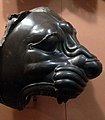
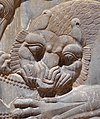
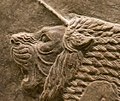
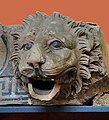

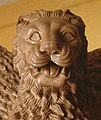


![Griffin of Pataliputra.[4]](https://upload.wikimedia.org/wikipedia/commons/thumb/d/dd/Patna_griffin.jpg/105px-Patna_griffin.jpg)